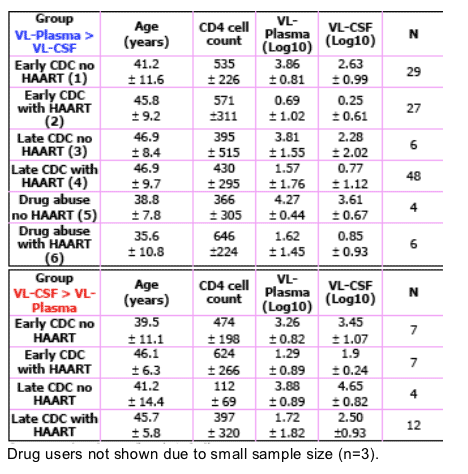 |
 |
 |
| |
HIV in CSF Associated with Neurological Impairment
|
| |
| |
http://www.docguide.com
by Norra MacReady
Note from Jules Levin: these data suggest patients need to include drugs in HAART that reduce CSF HIV viral load and drugs that penetrate the CSF.
LOS ANGELES, CA -- March 5, 2007 -- Patients with HIV who have a heavy viral load in their cerebrospinal fluid (CSF) compared with their plasma HIV loads show markedly worse results on neuropsychological tests, even in the absence of overt clinical deficits, investigators reported here at the 14th Conference on Retroviruses and Opportunistic Infections (CROI).
"We found worse neuropsychological test results when the viral load in the CSF exceeded that in the plasma," Thorsten Nolting, MD, University Hospital of Duesseldorf, Duesseldorf, Germany, said in his poster session on March 1st.
Dr. Nolting and colleagues studied 144 consecutive patients who were infected with HIV-1 but were asymptomatic. Of those patients, 33 (29%) had a higher viral load in the CSF than in the plasma. Each group was further divided according to whether they had early- or late-stage infection, with and without concurrent highly active antiretroviral therapy (HAART), and history of drug abuse for a total of 6 subgroups in each category.
Patients were tested for motor and cognitive function, including a pure motor test, Trailmaking Test forms A and B, the Digital Symbol Test, Grooved Pegboard Test, and AIDS Dementia Test, among others.
Among patients whose viral loads in the CSF were higher than in plasma, those with late-stage infection but no HAART showed severe impairment in the pure motor, Trailmaking, Grooved Pegboard, and cognitive function tests. Mild and moderate impairments were noted in patients with earlier-stage infections, even when they were on HAART.
By contrast, among patients with a greater plasma than CSF viral load, the late-stage subgroup that was not on HAART showed severe impairment only on Trailmaking Test B. The other patients in this category showed mild to moderate impairments on the pure motor tests, but no other impairments in the tests of cognitive function.
These findings suggest that there is a subgroup of HIV-infected patients in whom the virus is able to penetrate the blood brain barrier, and who may be more vulnerable to neurocognitive manifestations of the illness, Dr. Nolting said. He recommended that all newly diagnosed patients undergo a lumbar puncture to determine CSF viral loads.
It is still unclear how the virus can enter the CSF, he added. Immune cells like monocytes or macrophages may act as carriers, or there may be some other explanation that has yet to be discovered. "After 20 years of research, we still don't know the mechanism by which the virus crosses the blood-brain barrier."
[Presentation title: Distinct Neuropsychological Deficit Pattern in HIV-1+ Patients with Higher CSF Than Plasma Viral Load. Poster 385]
POSTER
Distinct neuropsychological deficit patterns in HIV-1 positive patients with
higher CSF than plasma viral load
Arendt G.1, Nolting T.1, Husstedt I.-W.2, Gregor N. 2, Koutsilieri E.3, Maschke M.4, Obermann M. 4, Sopper S.5, Riederer P.3,
ter Meulen V.6
1 Dept. of Neurology, University Hospital of Duesseldorf, Germany
2 Dept. of Neurology, University Hospital of Muenster, Germany
3 Dept. of Psychiatry, Neurochemistry, University Hospital of Wuerzburg, Germany
4 Dept. of Neurology, University Hospital of Essen-Duisburg, Germany
5 German Primate Centre, Goettingen, Germany
6 Dept. of Virology and Immunobiology, University of Wuerzburg, Germany
Competence Network HIV/AIDS
Background:
The significance of cerebrospinal fluid (CSF) viral load (VL) for cerebral dysfunction in HIV-1-positive patients is unclear. This study presents the results of a broad neuropsychological test battery that was used to
examine 153 HIV-positive patients without overt neurological deficits.
Methods:
Patients were recruited consecutively. 120/153 HIV-1 carriers had higher plasma than CSF-VL, 33 (21.6 %) vice versa. Both patient groups were subdivided into six subgroups: Groups 1 + 2 = early CDC stage (A1+2, B1+2) patients +/- HAART, groups 3 +4 = late CDC
stage (A3, B3, C1-3) patients +/- HAART, groups 5+6 = drug abusers +/- HAART.
RESULTS


Conclusions:
HIV-1-positive patients without overt clinical deficits, but with higher CSF than plasma VL - a surprisingly high percentage in this cohort - showed marked pathological neuropsychological test profiles in contrast to individuals with higher plasma VL who reveal only mild to moderate motor, but no cognitive deficits. The reasons for these findings have to be evaluated in further studies.
|
| |
|
 |
 |
|
|